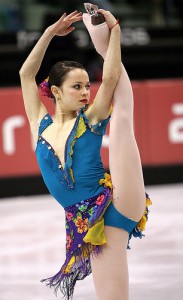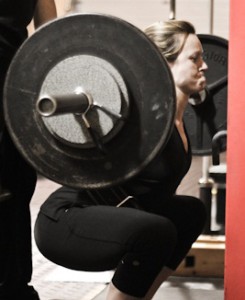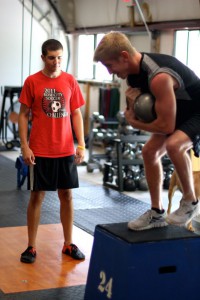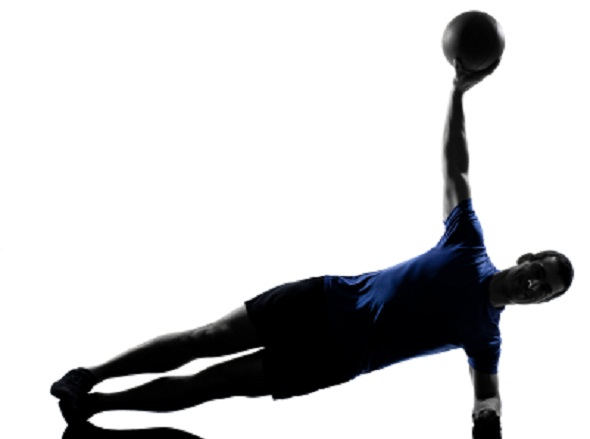As an industry, we love ourselves some mobility.
It’s like we can’t get enough – foam rolling, static stretching, mobility drills and exercises, Yoga, Pilates, the list goes on and on.
And don’t get me wrong – I fully respect the need for mobility.
In fact, I’ve championed the need for mobility since at least 2003 or 2004. From a training perspective, mobility is literally the foundation of quality movement.
But with that being said, I think it’s important to note both sides of the equation.
While mobility is important, I would argue that it’s every bit as imperative that we be able to stabilize, or control, the mobility that we have as well.
Let’s start with a practical example.
The Figure Skater or Dancer
When I think of amazing mobility, two types of athletes that immediately come to mind are figure skaters and dancers.
two types of athletes that immediately come to mind are figure skaters and dancers.
Just watch these athletes move, and they will awe you with their athleticism and grace.
But if you look beyond the surface and dig a bit deeper, you’ll find that many of these athletes end up with horrible spines, in spite of their incredible amounts of mobility.
How, you might ask?
It’s not a lack of mobility – in their case, it’s a lack of stability.
To be more specific, it’s their inability to stabilize throughout their (quite large) range of motion.
But that’s only one reason we should strive to improve stability.
If you lack stability, sure, you could end up injured. But if your goal is to push bigger squats, benches or deadlifts, lack of stability will now allow you to recruit your big prime movers.
Basically, you’ll be weaker.
If you’re an athlete that’s forced to plant and cut, the same thing occurs.
If you’re unstable you go hard into a cut, but if you don’t have the ability to stabilize and control you ankle, knee, hip and trunk, you’ll be “moving” too much. The goal would be to go in hard, lock the body down, and come out fast and explosive.
So the next question becomes, how do we train for stability?
What tools do we have in our toolbox?
I’m glad you asked!
Stability Training 101
Here at IFAST, we use all sorts of training mediums to improve someone’s stability. Today, we’re just going to focus on some of the most basic and readily available methods you can use in the gym to improve stability.
In no particular order, here are four training methods you can use to improve stability:
- Eccentric training
- Isometric training
- Tempo training
- Split-Stance and Unilateral Training
- Optimizing the Diaphragm
Let’s explore each one in depth.
Eccentric Training
Eccentric training is a fantastic way to increase stability. Many athletes and lifters alike will have a tendency to move explosively throughout the range of motion, but specifically on the eccentric.
Good athletes are adept at using their stiffness to move heavy weights or act explosively. Eccentric training takes that reliance on the stretch shortening cycle away, forcing them to lean on and develop the muscles instead.
The benefits of controlled eccentrics are numerous. Most importantly, slowing down the eccentric component of the lift develops the connective tissue to a high degree, but also improves our proprioception, positional and spatial awareness.
If you want to start incorporating slower eccentrics in your program, I’d start by using a 401 or 301 tempo on your big lift for the day. This is a great starting point, but you can take it even a step further.
(If you need a primer on tempo training or TUT, please read this T-Nation article I wrote on the topic.)
If you follow the work of Cal Dietz (head strength coach at the University of Minnesota), you’ll see he includes blocks of eccentric training where the lowering portion of the lifts takes as long as 6 seconds each rep!
Trust me, if you’re taking 6 seconds to lower a squat or bench press, you’re going to develop a high degree of stability and control!
Isometric Training
The second way to improve stability is with isometric training, or ISOs. While I’ve always dabbled with them myself, it wasn’t until I spent some time training under Mike Tuscherer that I really came to respect the value and role of ISOs in my training programs.
While ISO’s can typically be held throughout any point in the range of motion, you’ll most often see them held at the midpoint of the exercise. For example in a squat, you would hold the very bottom position.
throughout any point in the range of motion, you’ll most often see them held at the midpoint of the exercise. For example in a squat, you would hold the very bottom position.
For a bench press, you’d perform your ISO when the bar is touching your chest.
For a chin-up or pull-up, you’d hold the top position of the lift, where your chest is touching the bar. (For more on chin-ups, see my blog post on Conquering the Chin-up.)
Again, while you can perform ISOs anywhere throughout the range of motion, I think you’ll get the most benefit (and the most transfer) by holding in that position where your joint angles are in the position of least mechanical advantage.
To use ISOs in your training, start by throwing in some drop sets after your main exercise. Let’s say you’re squatting, and you work up to 200 pounds. Cut that weight by 30-40%, and then perform 2 sets of 2-3 reps with a 2-3 second paused isometric in the bottom.
Not only will this improve kinesthetic awareness and proprioception similar to our eccentrics, but also these ISOs will build a tremendous about of stability and strength out of the bottom position.
Tempo Training
Tempo training is our third style of stability training, and it’s very similar to the first two we outlined.
In tempo training, the goal is to move continuously. If you’re squatting, the goal should be to lower for 2 seconds, and then perhaps more importantly, rise for 2 seconds as well.
Finally, there’s no pausing or resting at any point in the range of motion – the reps must be continuous.
While the primary goal of tempo training is to develop specific oxidative capacity, it’s also a fantastic way to develop stability.
I’m starting to sound like a broken record here, but slow and controlled tempo training develops kinesthetic and positional awareness. This is just another method that you can throw in, either as part of an aerobic training block, or as a mini-block to help maintain stability and control while you focus on more explosive or strength-focused styles of training.
Split-Stance and Single-Leg Work
Last but not least, single-leg and split-stance training is an ideal constituent part of any stability-focused program.
I know everyone is in love with single-leg work these days, and I get it. After all, I didn’t create an entire product around single-leg training just because I was bored and had too much free time on my hands!
But I also think we often go about single-leg and split-stance training in a totally incorrect manner.
The primary goal of single-leg training should not be to show how much weight we can handle. Instead, the primary goal of single-leg training should be to demonstrate amazing stability and control.

How many times have you seen people performing step-ups, split-squats or lunges in the gym with ridiculous loads, and they’re literally falling all over the place?
Instead, use the single-leg lifts to improve stability and control, so that when you do your big lifts like squats and deadlifts, your stabilizers are up to snuff and allow your prime movers to demonstrate their true strength and capacity.
While I’m rarely (if ever) going to use a single-leg exercise as my main lift of the day, I try and get at least one single-leg exercise in almost every time I train legs. The benefits are numerous, and this is the case even if your primary goal is to be explosive and awesome on two legs (e.g., powerlifting, Olympic lifting, throwing, etc.)
If you combine single-leg work with some of the methods I outlined above (eccentrics, ISO’s, tempo work, etc.), you have a recipe for some serious stability.
Optimizing the Diaphragm
An in-depth discussion on the diaphragm and respiration goes far beyond what I can cover here, but I’d be remiss if I didn’t at least mention the need for improved diaphragmatic breathing and function.
I can make an argument that if you don’t have good stability through the diaphragm and core, you won’t have optimal stability anywhere else in the chain.
At IFAST, we could link issues in the upper back, neck, core, and even down to the lower extremity on a poorly functioning (or poorly aligned) diaphragm!
A good starting point here would be to focus on improved respiration patterns, most notably getting the diaphragm moving and shaking. I discussed this in depth in my Complete Core Fitness product, and we’ll be covering it extensively in our Diagnosis Fitness course as well.
Summary
Whether your goal is to ball out on the court or field, hoist heavy weights up and down, or simply dominate life, improving your stability can get you there in a safe and more effective manner.
Utilize some of the prescriptions I’ve outlined above over the next 6-8 weeks, and I guarantee you’re going to feel stronger and more stable as a result.
Good luck and good training!
Stay strong,
MR
P.S. – Over the past 10 years, I’ve put well over 1,000 pieces of FREE content out on the Interwebz via blogs, articles, podcasts, newsletters, etc.
If you enjoy the content I produce, please help me out by sharing it with your friends! Share it on Facebook, re-tweet it on Twitter, or just e-mail the link to a friend who may benefit from it.
I appreciate your support! Thanks!
Photo of figure skater Sasha Cohen by zipckr on Flickr (Creative Commons)

